Hadean geodynamics inferred from time-varying 142Nd/144Nd in the early Earth rock record
Affiliations | Corresponding Author | Cite as | Funding information- Share this article





Article views:5,332Cumulative count of HTML views and PDF downloads.
- Download Citation
- Rights & Permissions
top
Abstract
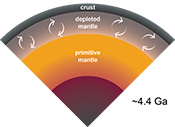
Figures and Tables
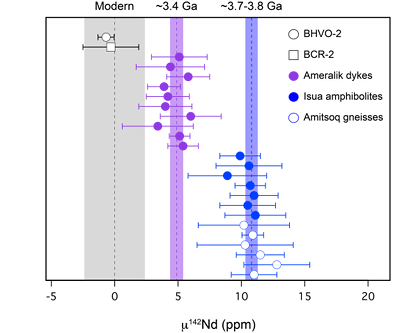 Figure 1 The μ142Nd composition relative to JNdi-1 for terrestrial rock standards and rocks from Isua Supracrustal Belt. Error bars for each sample indicate the internal errors (2 SE). The grey band for modern samples is the 2 SD external reproducibility (Saji et al., 2016). The light purple band represent the weighted mean and 2σ uncertainty (MSWD = 0.9) of the Palaeoarchean (~3.4 Ga) samples whereas the light blue band represent the weighted mean and 2σ uncertainty (MSWD = 0.5) of the Eoarchean (3.7-3.8 Ga) samples. | 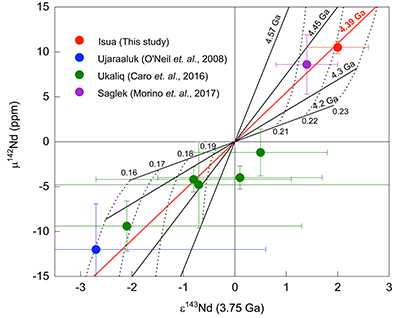 Figure 2 Two stage coupled 147,146Sm–142,143Nd systematics for ~3.75 Ga Isua amphibolites. Solid black lines are loci of constant model ages calculated with bulk silicate Earth parameters of μ142Nd = 0 and 147Sm/144Nd = 0.196. Dashed curves represent loci of constant time-integrated (147Sm/144Nd) source ratios. The red line is a linear regression for all samples and corresponds to a model age of 4390 ± 20 Ma. The Ujaraaluk data point is the mean of faux amphibolites from O’Neil et al. (2008). The Saglek data point is the mean of Eoarchean amphibolites from Morino et al. (2017). The Ukaliq data corresponds to enriched, boninitic and transitional mafic rocks as well as Voizel suite TTGs from Caro et al. (2017). The ε143Nd (3.75 Ga) value for Isua amphibolites is from Moorbath et al. (1997). | 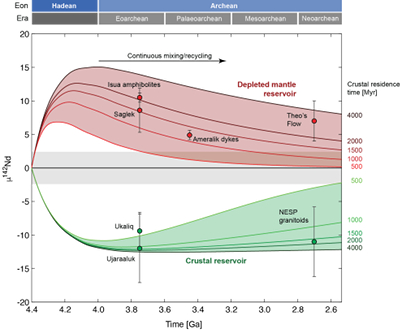 Figure 3 μ142Nd evolution of the depleted mantle and complementary crust as calculated by a continually interacting crust-mantle box model. The different coloured curves correspond to crustal residence times between 500 to 4000 Myr. The evolution of Isua μ142Nd data is best fitted for residence times between 1000-2000 Myr. Sensitivity of the inferred residence times to model parameters is detailed in Table S-5. The Hadean crustal component identified in Eoarchean Ujaraaluk and Ukaliq units in Nuvvuagittuq Supracrustal Belt and Neoarchean North Easter Superior Province (NESP) granitoids are also in agreement with crustal residence time of 1000-2000 Myr (O’Neil et al., 2012; Caro et al., 2017; O’Neil and Carlson, 2017). Inferred crustal residence times are also consistent within error with the μ142Nd data for Theo’s Flow (Debaille et al., 2013). | 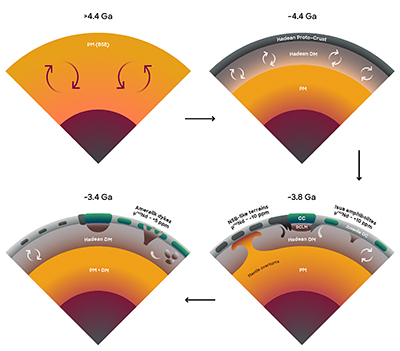 Figure 4 A schematic diagram illustrating the evolution of Isua Hadean depleted mantle and proto-crust. The Hadean depleted mantle (DM) and proto-crust formed by primary differentiation at ~4.45-4.36 Ga following the Moon-forming event. The Hadean proto-crust acts as a stagnant-lid due to its buoyancy and is reworked and recycled into the mantle during large-scale deep mantle upwellings in a lid-overturn tectonic regime (Bédard, 2018). Basaltic magmatism thickens the oceanic crust (OC) and results in formation of continental crust (CC) by intra-crustal melting and ensures stabilisation of cratons with a depleted subcontinental lithospheric mantle (SCLM) keel. ISB amphibolites are derived in the Eoarchean from the convecting Hadean DM metasomatised by crust-derived fluids. The NSB rocks possibly formed during reworking of the Hadean proto-crust in mantle overturn episodes recycling portions of the crust into the mantle. Ameralik dykes form in the Palaeoarchean during a delamination episode triggering decompression melting of the Isua Hadean DM. |
| Figure 1 | Figure 2 | Figure 3 | Figure 4 |
top
Introduction
The short-lived 146Sm-142Nd decay system provides a powerful tool for studying the early evolution of silicate Earth. The presence of 142Nd/144Nd variations relative to bulk silicate Earth represent irrefutable evidence for mantle differentiation prior to 4.0 Ga. The most extensively studied terrain for 142Nd/144Nd heterogeneity is the Isua Supracrustal Belt (SW Greenland) that contains well-preserved Eoarchean rocks carrying the highest 142Nd/144Nd excesses reported so far (e.g., Caro et al., 2006
Caro, G., Bourdon, B., Birck, J.L., Moorbath, S. (2006) High-precision 142Nd/144Nd measurements in terrestrial rocks: Constraints on the early differentiation of the Earth’s mantle. Geochimica et Cosmochimica Acta 70, 164-191.
). A decreasing trend in 142Nd/144Nd anomalies with time for the Greenland rocks, suggesting progressive convective homogenisation of fractionated mantle domains, has been proposed (Bennett et al., 2007Bennett, V.C., Brandon, A.D., Nutman, A.P. (2007) Coupled 142Nd-143Nd Isotopic Evidence for Hadean Mantle Dynamics. Science 318, 1907-1910.
; Rizo et al., 2013Rizo, H., Boyet, M., Blichert-Toft, J., Rosing, M.T. (2013) Early mantle dynamics inferred from 142Nd variations in Archean rocks from southwest Greenland. Earth and Planetary Science Letters 377, 324-335.
). However, the rate of homogenisation is not well-constrained due to the excessive scatter in the 142Nd/144Nd data. The extent of 142Nd/144Nd variability within a rock suite that has been assigned a single geological age is 2-5 times the analytical reproducibility, precluding identification of the exact course of 142Nd evolution. Thus, highly precise 142Nd/144Nd data for Archean rocks of varying ages is necessary to constrain the tempo of survival of Hadean 142Nd/144Nd anomalies and, hence, gain insights into early Earth dynamics.top
Results
We studied Eoarchean amphibolites (>3.8 Ga) and Amitsoq gneisses (3.8-3.7 Ga) as well as Palaeoarchean Ameralik dykes (~3.45 Ga) from the Isua Supracrustal Belt for their chemistry and Sm-Nd isotope systematics, the latter measured using an ultra-high precision protocol employing multiple collector inductively-coupled plasma source mass spectrometry (Saji et al., 2016
Saji, N.S., Wielandt, D., Paton, C., Bizzarro, M. (2016) Ultra-high-precision Nd-isotope measurements of geological materials by MC-ICPMS. Journal of Analytical Atomic Spectrometry 31, 1490-1504.
). The 142Nd/144Nd compositions are reported in the μ notation as parts per million deviations (ppm) from the standard (Fig. 1 and Table S-3). The Eoarchean amphibolites define a weighted mean µ142Nd composition of 10.5 ± 0.7 (2σ; n = 7) indistinguishable from the mean composition of the Amitsoq gneisses, which is 11.4 ± 0.7 (2σ; n = 6). These results are similar to previous measurements of Eoarchean ISB rocks by thermal ionisation mass spectrometry but define a much narrower compositional range for both lithologies in our study (Fig. S-16). The gneisses from the northern terrane, for which zircon U-Pb analyses define an age of 3701 ± 2 Ma, record a µ142Nd composition (~11 ppm) indistinguishable from that of the tectonically distinct southern terrane that yield zircon U-Pb ages of 3803 ± 3 Ma (Fig. S-14), in contrast to Bennett et al. (2007)Bennett, V.C., Brandon, A.D., Nutman, A.P. (2007) Coupled 142Nd-143Nd Isotopic Evidence for Hadean Mantle Dynamics. Science 318, 1907-1910.
that suggest a decrease in μ142Nd from ~20 ppm at 3.85 Ga to ~15 ppm by 3.7 Ga. We conclude that the Eoarchean ~3.75 Ga crust in Isua has a homogeneous μ142Nd composition of ~11 ppm inherited from a precursor mafic crust represented by the Isua amphibolites. The Palaeoarchean ~3.45 Ga metadoleritic Ameralik dykes carry a lower but well-resolved μ142Nd excess of 4.9 ± 0.5 (2σ; n = 10), in contrast to an earlier study that measured variable µ142Nd compositions as negative as –13 ppm in samples collected from similar localities as in this study (Rizo et al., 2012Rizo, H., Boyet, M., Blichert-Toft, J., O’Neil, J., Rosing, M.T., Paquette, J.L. (2012) The elusive Hadean enriched reservoir revealed by 142Nd deficits in Isua Archaean rocks. Nature 491, 96-100.
). The excessive scatter in the μ142Nd data of Rizo et. al. (2012)Rizo, H., Boyet, M., Blichert-Toft, J., O’Neil, J., Rosing, M.T., Paquette, J.L. (2012) The elusive Hadean enriched reservoir revealed by 142Nd deficits in Isua Archaean rocks. Nature 491, 96-100.
that span from –13.3 ± 3.6 to +5.4 ± 3.2 ppm is not present in our high precision data set and potentially reflects analytical artifacts (see Section 2.4 of Supplementary Information for details).
Figure 1 The μ142Nd composition relative to JNdi-1 for terrestrial rock standards and rocks from Isua Supracrustal Belt. Error bars for each sample indicate the internal errors (2 SE). The grey band for modern samples is the 2 SD external reproducibility (Saji et al., 2016
Saji, N.S., Wielandt, D., Paton, C., Bizzarro, M. (2016) Ultra-high-precision Nd-isotope measurements of geological materials by MC-ICPMS. Journal of Analytical Atomic Spectrometry 31, 1490-1504.
). The light purple band represent the weighted mean and 2σ uncertainty (MSWD = 0.9) of the Palaeoarchean (~3.4 Ga) samples whereas the light blue band represent the weighted mean and 2σ uncertainty (MSWD = 0.5) of the Eoarchean (3.7-3.8 Ga) samples.top
Discussion
Steady-stage coupled 142Nd-143Nd systematics of Eoarchean amphibolites constrain the formation age of Isua depleted mantle reservoir to 4390 ± 20 Myr (146Sm t1/2 = 103 Myr). Interestingly, the negative µ142Nd anomalies measured in ~3.75 Ga tonalite-trondjemite-granodiorite (TTG) gneisses and Ujaraaluk unit amphibolites from Nuvvuagittuq Supracrustal Belt as well as the tholeiitic to enriched lavas from Ukaliq Supracrustal Belt (O’Neil et al., 2008
O'Neil, J., Carlson, R.W., Francis, D., Stevenson, R.K. (2008) Neodymium-142 evidence for hadean mafic crust. Science 31, 1828-1831.
, 2012O’Neil, J., Carlson, R.W., Paquette, J. L., Francis, D. (2012) Formation age and metamorphic history of the Nuvvuagittuq Greenstone Belt. Precambrian Research 221, 23-24.
; Roth et al., 2013Roth, A.S.G., Bourdon, B., Mojzsis, S.J., Touboul, M., Sprung, P., Guitreau, M., Blichert-Toft, J. (2013) Inherited 142Nd anomalies in Eoarchean protoliths. Earth and Planetary Science Letters 361, 50-57.
; Caro et al., 2017Caro, G., Morino, P., Mojzsis, S.J., Cates, N.L., Bleeker, W. (2017) Sluggish Hadean geodynamics: Evidence from coupled 146,147Sm–142,143Nd systematics in Eoarchean supracrustal rocks of the Inukjuak domain (Québec). Earth and Planetary Science Letters 457, 23-37.
), both in the North Eastern Superior Province (Canada), define a single isochron as the Isua amphibolites corresponding to a large scale Hadean differentiation event forming Isua depleted mantle and complementary proto-crust at 4.39 Ga (Fig. 2). The model differentiation age is consistent with the estimated ages (~4.35-4.40 Ga) for crystallisation of lunar magma ocean (Gaffney and Borg, 2014Gaffney, A.M., Borg, L.E. (2014) A young solidification age for the lunar magma ocean. Geochimica et Cosmochimica Acta 140, 227-240.
) and the oldest terrestrial zircons (~4.37 Ga; Whitehouse et al., 2017Whitehouse, M.J., Nemchin, A.A., Pidgeon, R.T. (2017) What can Hadean detrital zircon really tell us? A critical evaluation of their geochronology with implications for the interpretation of oxygen and hafnium isotopes. Gondwana Research 51, 78-91.
). The correspondence between the timing of this Hadean differentiation event and crystallisation of the lunar magma ocean potentially suggests that the Isua depleted mantle reservoir represents a primordial mantle domain that formed following solidification of the terrestrial magma ocean after the Moon-forming impact (Canup, 2012Canup, R. (2012) Forming a moon with an Earth-like composition via a giant impact. Science 338, 1052–1055.
; Carlson et al., 2015Carlson, R.W., Boyet, M., O'Neil, J., Rizo, H., Walker, R.J. (2015) Early Differentiation and Its Long‐Term Consequences for Earth Evolution. In: Badro, J. Walter, M. (Eds.) The Early Earth. American Geophysical Union Geophysical Monograph 212. John Wiley & Sons, Inc., Hoboken, 143-172.
; Caro et al., 2017Caro, G., Morino, P., Mojzsis, S.J., Cates, N.L., Bleeker, W. (2017) Sluggish Hadean geodynamics: Evidence from coupled 146,147Sm–142,143Nd systematics in Eoarchean supracrustal rocks of the Inukjuak domain (Québec). Earth and Planetary Science Letters 457, 23-37.
). The time-integrated 147Sm/144Nd ratio derived from the two stage model for the Isua depleted mantle is ~0.22 ± 0.01 and the complementary Hadean protocrust is basaltic (147Sm/144Nd = ~0.17). Magma ocean crystallisation models for Earth-size planets predict the primordial crust to be of basaltic composition formed by decompression melting of portions of Hadean mantle after the primary mantle overturn (Elkins-Tanton, 2008Elkins-Tanton, L.T. (2008) Linked magma ocean solidification and atmospheric growth for Earth and Mars. Earth and Planetary Science Letters 271, 181-191.
).
Figure 2 Two stage coupled 147,146Sm–142,143Nd systematics for ~3.75 Ga Isua amphibolites. Solid black lines are loci of constant model ages calculated with bulk silicate Earth parameters of μ142Nd = 0 and 147Sm/144Nd = 0.196. Dashed curves represent loci of constant time-integrated (147Sm/144Nd) source ratios. The red line is a linear regression for all samples and corresponds to a model age of 4390 ± 20 Ma. The Ujaraaluk data point is the mean of faux amphibolites from O’Neil et al. (2008)
O'Neil, J., Carlson, R.W., Francis, D., Stevenson, R.K. (2008) Neodymium-142 evidence for hadean mafic crust. Science 31, 1828-1831.
. The Saglek data point is the mean of Eoarchean amphibolites from Morino et al. (2017)Morino, P., Caro, G., Reisberg, L., Schumacher, A. (2017) Chemical stratification in the post-magma ocean Earth inferred from coupled 146,147Sm-142,143Nd systematics in ultramafic rocks of the Saglek block (3.25–3.9 Ga; northern Labrador, Canada). Earth and Planetary Science Letters 463, 136-150.
. The Ukaliq data corresponds to enriched, boninitic and transitional mafic rocks as well as Voizel suite TTGs from Caro et al. (2017)Caro, G., Morino, P., Mojzsis, S.J., Cates, N.L., Bleeker, W. (2017) Sluggish Hadean geodynamics: Evidence from coupled 146,147Sm–142,143Nd systematics in Eoarchean supracrustal rocks of the Inukjuak domain (Québec). Earth and Planetary Science Letters 457, 23-37.
. The ε143Nd (3.75 Ga) value for Isua amphibolites is from Moorbath et al. (1997)Moorbath, S., Whitehouse, M.J., Kamber, B.S. Extreme (1997) Nd-isotope heterogeneity in the early Archaean-fact or fiction? Case histories from northern Canada and West Greenland. Chemical Geology 135, 213-231.
.The homogeneous μ142Nd in mantle-derived modern terrestrial rocks compared to the µ142Nd heterogeneity of Archean rocks is interpreted to reflect homogenisation by plate tectonic processes (e.g., Bennett et al., 2007)
Bennett, V.C., Brandon, A.D., Nutman, A.P. (2007) Coupled 142Nd-143Nd Isotopic Evidence for Hadean Mantle Dynamics. Science 318, 1907-1910.
. Thus, the subdued μ142Nd anomaly in the Palaeoarchean Ameralik dykes compared to the Eoarchean Isua rock suites can be interpreted as reflecting progressive homogenisation of the Hadean Isua depleted mantle reservoir by convective stirring if both rock types were derived from the same mantle domain. Trace element characteristics of Ameralik dykes are consistent with derivation from a non-metasomatised depleted mantle source (see Section 2.1 of Supplementary Information). This source lacks the recycled crustal components characterising the source of Eoarchean volcanics, but do not contain any plume-like or shallow lithospheric components to suggest derivation from a heterogeneous mantle other than the Isua depleted mantle (Figs. S-7, S-8 and S-9). Petrogenetic indicators suggest melting under shallow upper mantle conditions in the garnet stability field for both rock suites (Figs. S-4 and S-5). The nearly identical initial ε143Nd (2.0 ± 0.6 for Eoarchean amphibolites, Moorbath et al., 1997Moorbath, S., Whitehouse, M.J., Kamber, B.S. Extreme (1997) Nd-isotope heterogeneity in the early Archaean-fact or fiction? Case histories from northern Canada and West Greenland. Chemical Geology 135, 213-231.
; 3.0 ± 0.9 for Ameralik dykes, Rizo et al., 2012Rizo, H., Boyet, M., Blichert-Toft, J., O’Neil, J., Rosing, M.T., Paquette, J.L. (2012) The elusive Hadean enriched reservoir revealed by 142Nd deficits in Isua Archaean rocks. Nature 491, 96-100.
) is also consistent with derivation of both rock suites from an Archean depleted mantle (Vervoort and Blichert-Toft, 1999Vervoort, J.D., Blichert-Toft, J. (1999) Evolution of the depleted mantle: Hf isotope evidence from juvenile rocks through time. Geochimica et Cosmochimica Acta 63, 533-556.
). It is, therefore, conceivable that the Ameralik dykes were sourced from the convecting mantle beneath Isua that gave rise to the Eoarchean magmatism and carry the time-evolved µ142Nd fingerprint of the Hadean Isua depleted mantle reservoir.The μ142Nd anomaly of 4.9 ± 0.7 ppm carried by the Ameralik dykes at ~3.4 Ga suggests survival of the Hadean Isua depleted mantle that formed ≥4.39 Ga for at least ~1 Gyr, with the reduction in μ142Nd anomaly reflecting the pace of homogenisation in the Hadean-Archean mantle. We infer a mantle homogenisation timescale of 1.4 Gyr, given that the μ142Nd anomaly would be reduced to modern accessible mantle compositions by ~3.0 Ga and that the age of differentiation cannot be older than ~4.45 Ga (Fig. 3 and Table S-5). Mantle homogenisation timescales close to 1.4 Gyr translate to a mantle stirring timescale of ≤250 Myr (see Section 2.5 of Supplementary Information). The estimated early Earth mantle stirring timescale is also consistent with the stirring time of 100-250 Myr inferred from the dispersion in the ε143Nd of Archean rocks (Caro et al., 2006
Caro, G., Bourdon, B., Birck, J.L., Moorbath, S. (2006) High-precision 142Nd/144Nd measurements in terrestrial rocks: Constraints on the early differentiation of the Earth’s mantle. Geochimica et Cosmochimica Acta 70, 164-191.
). The stirring time inferred for upper mantle convection today from the isotopic dispersion in modern oceanic basalts is 250-750 Myr (Kellogg et al., 2002Kellogg, J.B., Jacobsen, S.B., O’Connell, R.J. (2002) Modeling the distribution of isotopic ratios in geochemical reservoirs. Earth and Planetary Science Letters 204, 183-202.
). Given the intra-oceanic supra-subduction zone-like setting inferred for Isua Eoarchean volcanics from their arc-like geochemistry, we consider the homogenisation of Isua depleted mantle reservoir to occur at length scales comparable to modern upper mantle convection. Thus, the shorter mantle stirring time of ≤250 Myr inferred for the Hadean-Archean mantle from the secular variation in the Isua μ142Nd data suggests the vigorous pace of convective stirring in the Hadean-Archean mantle that leads to compositional heterogeneities being mixed away at a rate faster than today (Olson et al., 1984Olson, P., Yuen, A.D., Balsiger, D. (1984) Mixing of passive heterogeneities by mantle convection. Journal of Geophysical Research 89, 425-436.
). This observation agrees with models that show Archean mantle convection to proceed at faster rates due to the lower viscosity from higher mantle temperatures (Coltice and Schmalzl, 2006Coltice, N., Schmalzl, J. (2006) Mixing times in the mantle of the early Earth derived from 2-D and 3-D numerical simulations of convection. Geophysical Research Letters 33, L23304.
).
Figure 3 μ142Nd evolution of the depleted mantle and complementary crust as calculated by a continually interacting crust-mantle box model. The different coloured curves correspond to crustal residence times between 500 to 4000 Myr. The evolution of Isua μ142Nd data is best fitted for residence times between 1000-2000 Myr. Sensitivity of the inferred residence times to model parameters is detailed in Table S-5. The Hadean crustal component identified in Eoarchean Ujaraaluk and Ukaliq units in Nuvvuagittuq Supracrustal Belt and Neoarchean North Easter Superior Province (NESP) granitoids are also in agreement with crustal residence time of 1000-2000 Myr (O’Neil et al., 2012
O’Neil, J., Carlson, R.W., Paquette, J. L., Francis, D. (2012) Formation age and metamorphic history of the Nuvvuagittuq Greenstone Belt. Precambrian Research 221, 23-24.
; Caro et al., 2017Caro, G., Morino, P., Mojzsis, S.J., Cates, N.L., Bleeker, W. (2017) Sluggish Hadean geodynamics: Evidence from coupled 146,147Sm–142,143Nd systematics in Eoarchean supracrustal rocks of the Inukjuak domain (Québec). Earth and Planetary Science Letters 457, 23-37.
; O’Neil and Carlson, 2017O’Neil, J., Carlson, R.W. (2017) Building Archean cratons from Hadean mafic crust. Science 355, 1199-1202.
). Inferred crustal residence times are also consistent within error with the μ142Nd data for Theo’s Flow (Debaille et al., 2013Debaille, V., O’Neill, C., Brandon, A.D., Haenecour, P., Yin, Q., Mattielli, N., Trieman, A.H. (2013) Stagnant-lid tectonics in early Earth revealed by 142Nd variations in late Archean rocks. Earth and Planetary Science Letters 373, 83-92.
).The secular evolution of mantle heterogeneity depends on whether the complementary crustal reservoir is introduced into the mantle convection cells via recycling. Stagnant-lid tectonics allows preservation of primordial mantle heterogeneities for timescales of several billion years (Debaille et al., 2013
Debaille, V., O’Neill, C., Brandon, A.D., Haenecour, P., Yin, Q., Mattielli, N., Trieman, A.H. (2013) Stagnant-lid tectonics in early Earth revealed by 142Nd variations in late Archean rocks. Earth and Planetary Science Letters 373, 83-92.
). The relatively efficient homogenisation of μ142Nd anomaly with time as seen in Isua rocks is consistent with a geodynamic regime that involves lithosphere recycling rather than stagnant-lid tectonics. Using a box model that considers material transport across continuously interacting crust and depleted mantle reservoirs, the observed evolution of Isua μ142Nd anomaly is well-reproduced for crustal residence times between 1000-2000 Myr (Fig. 3). The μ142Nd anomaly of ~7 ppm identified by Debaille et al. (2013)Debaille, V., O’Neill, C., Brandon, A.D., Haenecour, P., Yin, Q., Mattielli, N., Trieman, A.H. (2013) Stagnant-lid tectonics in early Earth revealed by 142Nd variations in late Archean rocks. Earth and Planetary Science Letters 373, 83-92.
in 2.7 Ga Theo’s Flow from the Abitibi Greenstone Belt also lies within error on the same evolution curve as Isua amphibolites but corresponds to crustal residence times of 2000-4000 Myr. Such long crustal residence timescales imply that the primordial mafic proto-crust, whose extraction between 4.45 Ga and 4.39 Ga created the Isua depleted mantle reservoir, survived complete recycling until the mid-Archean, allowing the positive mantle μ142Nd signatures to be sampled by juvenile Archean magmatism. These long crustal residence timescales in the Archean contrast sharply with the short lifetime of oceanic crust today (~200 Myr) prior to recycling at subduction zones (Hawkesworth et al., 2010Hawkesworth, C.J., Dhuime, B., Pietranik, A.B., Cawood, P.A., Kem, A.I.S., Storey, C.D. (2010) The generation and evolution of continental crust. Journal of the Geological Society (London) 167, 239-248.
), implying a tectonic regime in the early Earth different from modern plate tectonics. Numerical models show that flat slab subduction like that of today is less likely in the Archean and predict an intermittent drip-like subduction style reducing the efficiency of lithosphere recycling (van Hunen and van den Berg, 2008van Hunen, J., van den Berg, A.P. (2008) Plate tectonics on the early Earth: Limitations imposed by strength and buoyancy of subducted lithosphere. Lithos 103, 217-235.
). Several models suggest the prevalence of a stagnant-lid regime punctuated by episodes of vertical tectonics under the influence of strong mantle overturns in the early Archean (Debaille et al., 2013Debaille, V., O’Neill, C., Brandon, A.D., Haenecour, P., Yin, Q., Mattielli, N., Trieman, A.H. (2013) Stagnant-lid tectonics in early Earth revealed by 142Nd variations in late Archean rocks. Earth and Planetary Science Letters 373, 83-92.
; Sizova et al., 2015Sizova, E., Gerya, T., Stüwe, K., Brown, M. (2015) Generation of felsic crust in the Archean: A geodynamic modelling persepective. Precambrian Research 271, 198-224.
; Bédard, 2018Bédard, J.H. (2018) Stagnant lids and mantle overturns: Implications for Archaean tectonics, magmagenesis, crustal growth, mantle evolution, and the start of plate tectonics. Geoscience Frontiers 9, 19-49.
). Mobile-lid tectonics involving long-lived subduction possibly did not begin until the mid-Archean as evidenced by an apparent inflexion in the rate of continental crust generation at ~3.0 Ga (Dhuime et al., 2012Dhuime, B., Hawkesworth, C.J., Cawood, P.A., Storey, C.D. (2012) A Change in the Geodynamics of Continental Growth 3 Billion Years Ago. Science 335, 1334-1336.
), coinciding with the lifetime estimated here for the Hadean mafic proto-crust until 3.4-2.4 Ga. Although the preservation of primordial Hadean reservoirs for long timescales is consistent with a stagnant-lid tectonic regime, the rate of mantle homogenisation inferred from Isua 142Nd data cannot be accounted for by simple stagnant-lid tectonics and requires some degree of recycling of complementary crustal reservoir into the convecting depleted mantle. The disparity in the crustal residence times defined by Isua amphibolites, Ameralik dykes and Theo’s Flow possibly indicates the sporadic nature of mantle overturn-induced lithospheric recycling in the Archean and the subsequent variations in the rate of crustal recycling with time and between localities (Fig. 4). Identification of a transitional hybrid regime characterised by quiescent stagnant-lid intervals alternating with plate tectonic-like mantle overturns throughout most of the Archean lends credence to theoretical models (O’Neill et al., 2016O’Neill, C., Lenardic, A., Weller, M., Moresi, L., Quenette, S., Zhang, S. (2016) A window for plate tectonics in terrestrial planet evolution? Physics of the Earth and Planetary Interiors 255, 80-92.
) that suggest that plate tectonics as it operates today on Earth represents a transient phase in the evolution of planets.
Figure 4 A schematic diagram illustrating the evolution of Isua Hadean depleted mantle and proto-crust. The Hadean depleted mantle (DM) and proto-crust formed by primary differentiation at ~4.45-4.36 Ga following the Moon-forming event. The Hadean proto-crust acts as a stagnant-lid due to its buoyancy and is reworked and recycled into the mantle during large-scale deep mantle upwellings in a lid-overturn tectonic regime (Bédard, 2018
Bédard, J.H. (2018) Stagnant lids and mantle overturns: Implications for Archaean tectonics, magmagenesis, crustal growth, mantle evolution, and the start of plate tectonics. Geoscience Frontiers 9, 19-49.
). Basaltic magmatism thickens the oceanic crust (OC) and results in formation of continental crust (CC) by intra-crustal melting and ensures stabilisation of cratons with a depleted subcontinental lithospheric mantle (SCLM) keel. ISB amphibolites are derived in the Eoarchean from the convecting Hadean DM metasomatised by crust-derived fluids. The NSB rocks possibly formed during reworking of the Hadean proto-crust in mantle overturn episodes recycling portions of the crust into the mantle. Ameralik dykes form in the Palaeoarchean during a delamination episode triggering decompression melting of the Isua Hadean DM.top
Acknowledgements
This study was funded by grants from Danish National Research Foundation (DNRF97) and European Research Council (ERC Consolidator grant agreement 616027-STARDUST2ASTEROIDS) to M.B. We thank Richard Carlson and two anonymous reviewers for their constructive comments on this paper. This is publication 567 of the Nordsim facility.
Editor: Cin-Ty Lee
top
References
Bennett, V.C., Brandon, A.D., Nutman, A.P. (2007) Coupled 142Nd-143Nd Isotopic Evidence for Hadean Mantle Dynamics. Science 318, 1907-1910.
 Show in context
Show in context A decreasing trend in 142Nd/144Nd anomalies with time for the Greenland rocks, suggesting progressive convective homogenisation of fractionated mantle domains, has been proposed (Bennett et al., 2007; Rizo et al., 2013).
View in article
The gneisses from the northern terrane, for which zircon U-Pb analyses define an age of 3701 ± 2 Ma, record a µ142Nd composition (~11 ppm) indistinguishable from that of the tectonically distinct southern terrane that yield zircon U-Pb ages of 3803 ± 3 Ma (Fig. S-14), in contrast to Bennett et al. (2007) that suggest a decrease in μ142Nd from ~20 ppm at 3.85 Ga to ~15 ppm by 3.7 Ga.
View in article
The homogeneous μ142Nd in mantle-derived modern terrestrial rocks compared to the µ142Nd heterogeneity of Archean rocks is interpreted to reflect homogenisation by plate tectonic processes (e.g., Bennett et al., 2007).
View in article
Bédard, J.H. (2018) Stagnant lids and mantle overturns: Implications for Archaean tectonics, magmagenesis, crustal growth, mantle evolution, and the start of plate tectonics. Geoscience Frontiers 9, 19-49.
 Show in context
Show in context Several models suggest the prevalence of a stagnant-lid regime punctuated by episodes of vertical tectonics under the influence of strong mantle overturns in the early Archean (Debaille et al, 2013; Sizova et al, 2015; Bédard, 2018).
View in article
Figure 4 [...] The Hadean proto-crust acts as a stagnant-lid due to its buoyancy and is reworked and recycled into the mantle during large-scale deep mantle upwellings in a lid-overturn tectonic regime (Bédard, 2018).
View in article
Canup, R. (2012) Forming a moon with an Earth-like composition via a giant impact. Science 338, 1052–1055.
 Show in context
Show in context The correspondence between the timing of this Hadean differentiation event and crystallisation of the lunar magma ocean potentially suggests that the Isua depleted mantle reservoir represents a primordial mantle domain that formed following solidification of the terrestrial magma ocean after the Moon-forming impact (Canup, 2012; Carlson et al., 2015; Caro et al., 2017).
View in article
Carlson, R.W., Boyet, M., O'Neil, J., Rizo, H., Walker, R.J. (2015) Early Differentiation and Its Long‐Term Consequences for Earth Evolution. In: Badro, J. Walter, M. (Eds.) The Early Earth. American Geophysical Union Geophysical Monograph 212. John Wiley & Sons, Inc., Hoboken, 143-172.
 Show in context
Show in context The correspondence between the timing of this Hadean differentiation event and crystallisation of the lunar magma ocean potentially suggests that the Isua depleted mantle reservoir represents a primordial mantle domain that formed following solidification of the terrestrial magma ocean after the Moon-forming impact (Canup, 2012; Carlson et al., 2015; Caro et al., 2017).
View in article
Caro, G., Bourdon, B., Birck, J.L., Moorbath, S. (2006) High-precision 142Nd/144Nd measurements in terrestrial rocks: Constraints on the early differentiation of the Earth’s mantle. Geochimica et Cosmochimica Acta 70, 164-191.
 Show in context
Show in contextThe most extensively studied terrain for 142Nd/144Nd heterogeneity is the Isua Supracrustal Belt (SW Greenland) that contains well-preserved Eoarchean rocks carrying the highest 142Nd/144Nd excesses reported so far (e.g., Caro et al., 2006).
View in article
The estimated early Earth mantle stirring timescale is also consistent with the stirring time of 100-250 Myr inferred from the dispersion in the ε143Nd of Archean rocks (Caro et al., 2006).
View in article
Caro, G., Morino, P., Mojzsis, S.J., Cates, N.L., Bleeker, W. (2017) Sluggish Hadean geodynamics: Evidence from coupled 146,147Sm–142,143Nd systematics in Eoarchean supracrustal rocks of the Inukjuak domain (Québec). Earth and Planetary Science Letters 457, 23-37.
 Show in context
Show in context Interestingly, the negative µ142Nd anomalies measured in ~3.75 Ga tonalite-trondjemite-granodiorite (TTG) gneisses and Ujaraaluk unit amphibolites from Nuvvuagittuq Supracrustal Belt as well as the tholeiitic to enriched lavas from Ukaliq Supracrustal Belt (O’Neil et al., 2008, 2012; Roth et al., 2013; Caro et al., 2017), both in the North Eastern Superior Province (Canada), define a single isochron as the Isua amphibolites corresponding to a large scale Hadean differentiation event forming Isua depleted mantle and complementary proto-crust at 4.39 Ga (Fig. 2).
View in article
The correspondence between the timing of this Hadean differentiation event and crystallisation of the lunar magma ocean potentially suggests that the Isua depleted mantle reservoir represents a primordial mantle domain that formed following solidification of the terrestrial magma ocean after the Moon-forming impact (Canup, 2012; Carlson et al., 2015; Caro et al., 2017).
View in article
Figure 2 [...] The Ukaliq data corresponds to enriched, boninitic and transitional mafic rocks as well as Voizel suite TTGs from Caro et al. (2017).
View in article
Figure 3 [...] The Hadean crustal component identified in Eoarchean Ujaraaluk and Ukaliq units in Nuvvuagittuq Supracrustal Belt and Neoarchean North Easter Superior Province (NESP) granitoids are also in agreement with crustal residence time of 1000-2000 Myr (O’Neil et al., 2012; Caro et al., 2017; O’Neil and Carlson, 2017).
View in article
Coltice, N., Schmalzl, J. (2006) Mixing times in the mantle of the early Earth derived from 2-D and 3-D numerical simulations of convection. Geophysical Research Letters 33, L23304.
 Show in context
Show in context This observation agrees with models that show Archean mantle convection to proceed at faster rates due to the lower viscosity from higher mantle temperatures (Coltice and Schmalzl, 2006).
View in article
Debaille, V., O’Neill, C., Brandon, A.D., Haenecour, P., Yin, Q., Mattielli, N., Trieman, A.H. (2013) Stagnant-lid tectonics in early Earth revealed by 142Nd variations in late Archean rocks. Earth and Planetary Science Letters 373, 83-92.
 Show in context
Show in context Figure 3 [...] Inferred crustal residence times are also consistent within error with the μ142Nd data for Theo’s Flow (Debaille et al., 2013).
View in article
Stagnant-lid tectonics allows preservation of primordial mantle heterogeneities for timescales of several billion years (Debaille et al., 2013).
View in article
The μ142Nd anomaly of ~7 ppm identified by Debaille et al. (2013) in 2.7 Ga Theo’s Flow from the Abitibi Greenstone Belt also lies within error on the same evolution curve as Isua amphibolites but corresponds to crustal residence times of 2000-4000 Myr.
View in article
Several models suggest the prevalence of a stagnant-lid regime punctuated by episodes of vertical tectonics under the influence of strong mantle overturns in the early Archean (Debaille et al, 2013; Sizova et al, 2015; Bédard, 2018).
View in article
Dhuime, B., Hawkesworth, C.J., Cawood, P.A., Storey, C.D. (2012) A Change in the Geodynamics of Continental Growth 3 Billion Years Ago. Science 335, 1334-1336.
 Show in context
Show in context Mobile-lid tectonics involving long-lived subduction possibly did not begin until the mid-Archean as evidenced by an apparent inflexion in the rate of continental crust generation at ~3.0 Ga (Dhuime et al., 2012), coinciding with the lifetime estimated here for the Hadean mafic proto-crust until 3.4-2.4 Ga.
View in article
Elkins-Tanton, L.T. (2008) Linked magma ocean solidification and atmospheric growth for Earth and Mars. Earth and Planetary Science Letters 271, 181-191.
 Show in context
Show in contextMagma ocean crystallisation models for Earth-size planets predict the primordial crust to be of basaltic composition formed by decompression melting of portions of Hadean mantle after the primary mantle overturn (Elkins-Tanton, 2008).
View in article
Gaffney, A.M., Borg, L.E. (2014) A young solidification age for the lunar magma ocean. Geochimica et Cosmochimica Acta 140, 227-240.
 Show in context
Show in context The model differentiation age is consistent with the estimated ages (~4.35-4.40 Ga) for crystallisation of lunar magma ocean (Gaffney and Borg, 2014) and the oldest terrestrial zircons (~4.37 Ga; Whitehouse et al., 2017).
View in article
Hawkesworth, C.J., Dhuime, B., Pietranik, A.B., Cawood, P.A., Kem, A.I.S., Storey, C.D. (2010) The generation and evolution of continental crust. Journal of the Geological Society (London) 167, 239-248.
 Show in context
Show in contextThese long crustal residence timescales in the Archean contrast sharply with the short lifetime of oceanic crust today (~200 Myr) prior to recycling at subduction zones (Hawkesworth et al., 2010), implying a tectonic regime in the early Earth different from modern plate tectonics.
View in article
van Hunen, J., van den Berg, A.P. (2008) Plate tectonics on the early Earth: Limitations imposed by strength and buoyancy of subducted lithosphere. Lithos 103, 217-235.
 Show in context
Show in context Numerical models show that flat slab subduction like that of today is less likely in the Archean and predict an intermittent drip-like subduction style reducing the efficiency of lithosphere recycling (van Hunen and van den Berg, 2008).
View in article
Kellogg, J.B., Jacobsen, S.B., O’Connell, R.J. (2002) Modeling the distribution of isotopic ratios in geochemical reservoirs. Earth and Planetary Science Letters 204, 183-202.
 Show in context
Show in context The stirring time inferred for upper mantle convection today from the isotopic dispersion in modern oceanic basalts is 250-750 Myr (Kellogg et al., 2002).
View in article
Moorbath, S., Whitehouse, M.J., Kamber, B.S. Extreme (1997) Nd-isotope heterogeneity in the early Archaean-fact or fiction? Case histories from northern Canada and West Greenland. Chemical Geology 135, 213-231.
 Show in context
Show in context Figure 2 [...] The ε143Nd (3.75 Ga) value for Isua amphibolites is from Moorbath et al. (1997).
View in article
The nearly identical initial ε143Nd (2.0 ± 0.6 for Eoarchean amphibolites, Moorbath et al., 1997; 3.0 ± 0.9 for Ameralik dykes, Rizo et al., 2012) is also consistent with derivation of both rock suites from an Archean depleted mantle (Vervoort and Blichert-Toft, 1999).
View in article
Morino, P., Caro, G., Reisberg, L., Schumacher, A. (2017) Chemical stratification in the post-magma ocean Earth inferred from coupled 146,147Sm-142,143Nd systematics in ultramafic rocks of the Saglek block (3.25–3.9 Ga; northern Labrador, Canada). Earth and Planetary Science Letters 463, 136-150.
 Show in context
Show in context Figure 2 [...] The Saglek data point is the mean of Eoarchean amphibolites from Morino et al. (2017).
View in article
Olson, P., Yuen, A.D., Balsiger, D. (1984) Mixing of passive heterogeneities by mantle convection. Journal of Geophysical Research 89, 425-436.
 Show in context
Show in context Thus, the shorter mantle stirring time of ≤250 Myr inferred for the Hadean-Archean mantle from the secular variation in the Isua μ142Nd data suggests the vigorous pace of convective stirring in the Hadean-Archean mantle that leads to compositional heterogeneities being mixed away at a rate faster than today (Olson et al., 1984).
View in article
O'Neil, J., Carlson, R.W., Francis, D., Stevenson, R.K. (2008) Neodymium-142 evidence for hadean mafic crust. Science 31, 1828-1831.
 Show in context
Show in context Interestingly, the negative µ142Nd anomalies measured in ~3.75 Ga tonalite-trondjemite-granodiorite (TTG) gneisses and Ujaraaluk unit amphibolites from Nuvvuagittuq Supracrustal Belt as well as the tholeiitic to enriched lavas from Ukaliq Supracrustal Belt (O’Neil et al., 2008, 2012; Roth et al., 2013; Caro et al., 2017), both in the North Eastern Superior Province (Canada), define a single isochron as the isua amphibolites corresponding to a large scale Hadean differentiation event forming Isua depleted mantle and complementary proto-crust at 4.39 Ga (Fig. 2).
View in article
Figure 2 [...] The Ujaraaluk data point is the mean of faux amphibolites from O’Neil et al. (2008).
View in article
O’Neil, J., Carlson, R.W., Paquette, J. L., Francis, D. (2012) Formation age and metamorphic history of the Nuvvuagittuq Greenstone Belt. Precambrian Research 221, 23-24.
 Show in context
Show in contextInterestingly, the negative µ142Nd anomalies measured in ~3.75 Ga tonalite-trondjemite-granodiorite (TTG) gneisses and Ujaraaluk unit amphibolites from Nuvvuagittuq Supracrustal Belt as well as the tholeiitic to enriched lavas from Ukaliq Supracrustal Belt (O’Neil et al., 2008, 2012; Roth et al., 2013; Caro et al., 2017), both in the North Eastern Superior Province (Canada), define a single isochron as the Isua amphibolites corresponding to a large scale Hadean differentiation event forming Isua depleted mantle and complementary proto-crust at 4.39 Ga (Fig. 2).
View in article
Figure 3 [...] The Hadean crustal component identified in Eoarchean Ujaraaluk and Ukaliq units in Nuvvuagittuq Supracrustal Belt and Neoarchean North Easter Superior Province (NESP) granitoids are also in agreement with crustal residence time of 1000-2000 Myr (O’Neil et al., 2012; Caro et al., 2017; O’Neil and Carlson, 2017).
View in article
O’Neil, J., Carlson, R.W. (2017) Building Archean cratons from Hadean mafic crust. Science 355, 1199-1202.
 Show in context
Show in context Figure 3 [...] The Hadean crustal component identified in Eoarchean Ujaraaluk and Ukaliq units in Nuvvuagittuq Supracrustal Belt and Neoarchean North Easter Superior Province (NESP) granitoids are also in agreement with crustal residence time of 1000-2000 Myr (O’Neil et al., 2012; Caro et al., 2017; O’Neil and Carlson, 2017).
View in article
O’Neill, C., Lenardic, A., Weller, M., Moresi, L., Quenette, S., Zhang, S. (2016) A window for plate tectonics in terrestrial planet evolution? Physics of the Earth and Planetary Interiors 255, 80-92.
 Show in context
Show in contextIdentification of a transitional hybrid regime characterised by quiescent stagnant-lid intervals alternating with plate tectonic-like mantle overturns throughout most of the Archean lends credence to theoretical models (O’Neill et al., 2016) that suggest that plate tectonics as it operates today on Earth represents a transient phase in the evolution of planets.
View in article
Rizo, H., Boyet, M., Blichert-Toft, J., O’Neil, J., Rosing, M.T., Paquette, J.L. (2012) The elusive Hadean enriched reservoir revealed by 142Nd deficits in Isua Archaean rocks. Nature 491, 96-100.
 Show in context
Show in context The Palaeoarchean ~3.45 Ga metadoleritic Ameralik dykes carry a lower but well-resolved μ142Nd excess of 4.9 ± 0.5 (2σ; n = 10), in contrast to an earlier study that measured variable µ142Nd compositions as negative as –13 ppm in samples collected from similar localities as in this study (Rizo et al., 2012).
View in article
The excessive scatter in the μ142Nd data of Rizo et. al. (2012) that span from –13.3 ± 3.6 to +5.4 ± 3.2 ppm is not present in our high precision data set and potentially reflects analytical artifacts (see Section 2.4 of Supplementary Information for details).
View in article
The nearly identical initial ε143Nd (2.0 ± 0.6 for Eoarchean amphibolites, Moorbath et al., 1997; 3.0 ± 0.9 for Ameralik dykes, Rizo et al., 2012) is also consistent with derivation of both rock suites from an Archean depleted mantle (Vervoort and Blichert-Toft, 1999).
View in article
Rizo, H., Boyet, M., Blichert-Toft, J., Rosing, M.T. (2013) Early mantle dynamics inferred from 142Nd variations in Archean rocks from southwest Greenland. Earth and Planetary Science Letters 377, 324-335.
 Show in context
Show in context A decreasing trend in 142Nd/144Nd anomalies with time for the Greenland rocks, suggesting progressive convective homogenisation of fractionated mantle domains, has been proposed (Bennett et al., 2007; Rizo et al., 2013).
View in article
Roth, A.S.G., Bourdon, B., Mojzsis, S.J., Touboul, M., Sprung, P., Guitreau, M., Blichert-Toft, J. (2013) Inherited 142Nd anomalies in Eoarchean protoliths. Earth and Planetary Science Letters 361, 50-57.
 Show in context
Show in contextInterestingly, the negative µ142Nd anomalies measured in ~3.75 Ga tonalite-trondjemite-granodiorite (TTG) gneisses and Ujaraaluk unit amphibolites from Nuvvuagittuq Supracrustal Belt as well as the tholeiitic to enriched lavas from Ukaliq Supracrustal Belt (O’Neil et al., 2008, 2012; Roth et al., 2013; Caro et al., 2017), both in the North Eastern Superior Province (Canada), define a single isochron as the Isua amphibolites corresponding to a large scale Hadean differentiation event forming Isua depleted mantle and complementary proto-crust at 4.39 Ga (Fig. 2).
View in article
Saji, N.S., Wielandt, D., Paton, C., Bizzarro, M. (2016) Ultra-high-precision Nd-isotope measurements of geological materials by MC-ICPMS. Journal of Analytical Atomic Spectrometry 31, 1490-1504.
 Show in context
Show in context We studied Eoarchean amphibolites (>3.8 Ga) and Amitsoq gneisses (3.8-3.7 Ga) as well as Palaeoarchean Ameralik dykes (~3.45 Ga) from the Isua Supracrustal Belt for their chemistry and Sm-Nd isotope systematics, the latter measured using an ultra-high precision protocol employing multiple collector inductively-coupled plasma source mass spectrometry (Saji et al., 2016).
View in article
Figure 1 [...] The grey band for modern samples is the 2 SD external reproducibility (Saji et al., 2016).
View in article
Sizova, E., Gerya, T., Stüwe, K., Brown, M. (2015) Generation of felsic crust in the Archean: A geodynamic modelling persepective. Precambrian Research 271, 198-224.
 Show in context
Show in context Several models suggest the prevalence of a stagnant-lid regime punctuated by episodes of vertical tectonics under the influence of strong mantle overturns in the early Archean (Debaille et al, 2013; Sizova et al, 2015; Bédard, 2018).
View in article
Vervoort, J.D., Blichert-Toft, J. (1999) Evolution of the depleted mantle: Hf isotope evidence from juvenile rocks through time. Geochimica et Cosmochimica Acta 63, 533-556.
 Show in context
Show in contextThe nearly identical initial ε143Nd (2.0 ± 0.6 for Eoarchean amphibolites, Moorbath et al., 1997; 3.0 ± 0.9 for Ameralik dykes, Rizo et al., 2012) is also consistent with derivation of both rock suites from an Archean depleted mantle (Vervoort and Blichert-Toft, 1999).
View in article
Whitehouse, M.J., Nemchin, A.A., Pidgeon, R.T. (2017) What can Hadean detrital zircon really tell us? A critical evaluation of their geochronology with implications for the interpretation of oxygen and hafnium isotopes. Gondwana Research 51, 78-91.
 Show in context
Show in context The model differentiation age is consistent with the estimated ages (~4.35-4.40 Ga) for crystallisation of lunar magma ocean (Gaffney and Borg, 2014) and the oldest terrestrial zircons (~4.37 Ga; Whitehouse et al., 2017).
View in article
top
Supplementary Information
The Supplementary Information includes:
- 1. Material and Methods
- 2. Supplementary Text
- Tables S-1 to S-5
- Figures S-1 to S-17
- Supplementary Information References
Download the Supplementary Information (PDF).
Download the Supplementary Tables (Excel).
Figures and Tables
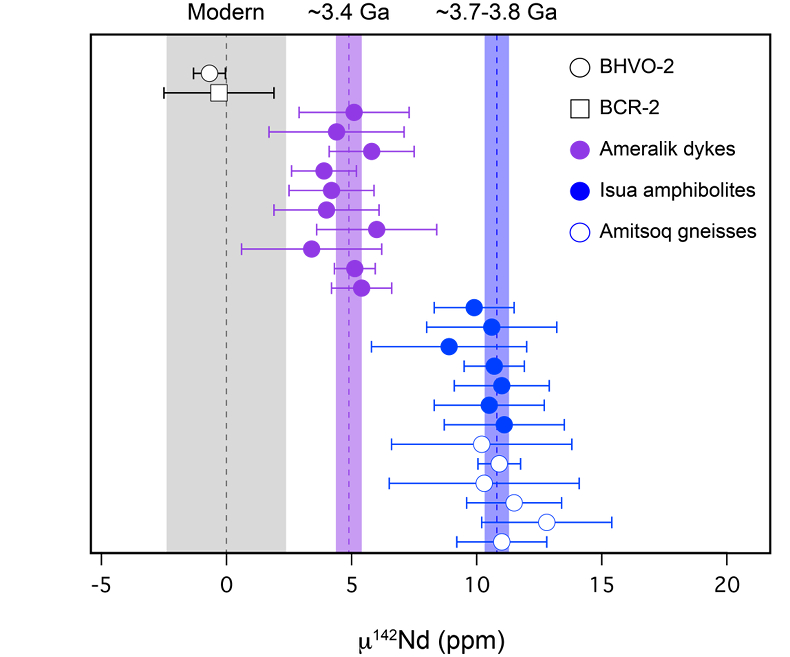
Figure 1 The μ142Nd composition relative to JNdi-1 for terrestrial rock standards and rocks from Isua Supracrustal Belt. Error bars for each sample indicate the internal errors (2 SE). The grey band for modern samples is the 2 SD external reproducibility (Saji et al., 2016
Saji, N.S., Wielandt, D., Paton, C., Bizzarro, M. (2016) Ultra-high-precision Nd-isotope measurements of geological materials by MC-ICPMS. Journal of Analytical Atomic Spectrometry 31, 1490-1504.
). The light purple band represent the weighted mean and 2σ uncertainty (MSWD = 0.9) of the Palaeoarchean (~3.4 Ga) samples whereas the light blue band represent the weighted mean and 2σ uncertainty (MSWD = 0.5) of the Eoarchean (3.7-3.8 Ga) samples.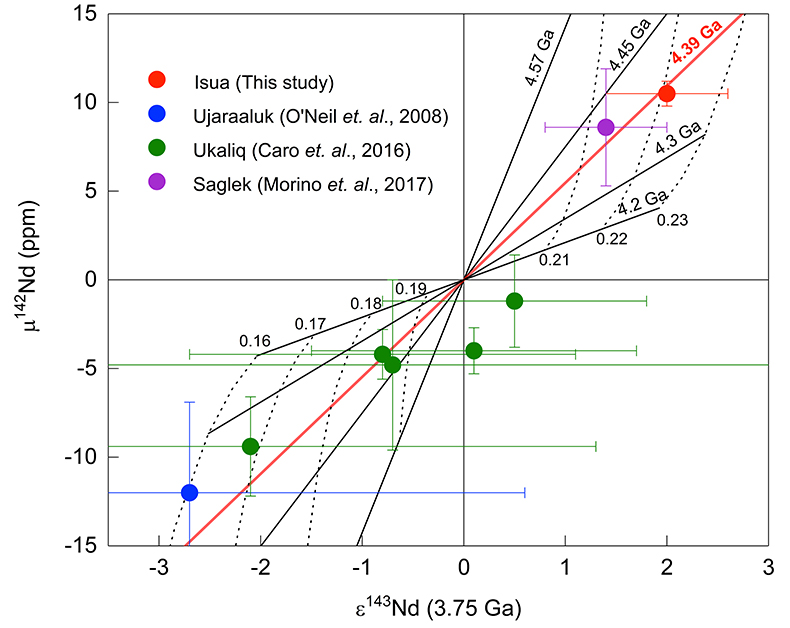
Figure 2 Two stage coupled 147,146Sm–142,143Nd systematics for ~3.75 Ga Isua amphibolites. Solid black lines are loci of constant model ages calculated with bulk silicate Earth parameters of μ142Nd = 0 and 147Sm/144Nd = 0.196. Dashed curves represent loci of constant time-integrated (147Sm/144Nd) source ratios. The red line is a linear regression for all samples and corresponds to a model age of 4390 ± 20 Ma. The Ujaraaluk data point is the mean of faux amphibolites from O’Neil et al. (2008)
O'Neil, J., Carlson, R.W., Francis, D., Stevenson, R.K. (2008) Neodymium-142 evidence for hadean mafic crust. Science 31, 1828-1831.
. The Saglek data point is the mean of Eoarchean amphibolites from Morino et al. (2017)Morino, P., Caro, G., Reisberg, L., Schumacher, A. (2017) Chemical stratification in the post-magma ocean Earth inferred from coupled 146,147Sm-142,143Nd systematics in ultramafic rocks of the Saglek block (3.25–3.9 Ga; northern Labrador, Canada). Earth and Planetary Science Letters 463, 136-150.
. The Ukaliq data corresponds to enriched, boninitic and transitional mafic rocks as well as Voizel suite TTGs from Caro et al. (2017)Caro, G., Morino, P., Mojzsis, S.J., Cates, N.L., Bleeker, W. (2017) Sluggish Hadean geodynamics: Evidence from coupled 146,147Sm–142,143Nd systematics in Eoarchean supracrustal rocks of the Inukjuak domain (Québec). Earth and Planetary Science Letters 457, 23-37.
. The ε143Nd (3.75 Ga) value for Isua amphibolites is from Moorbath et al. (1997)Moorbath, S., Whitehouse, M.J., Kamber, B.S. Extreme (1997) Nd-isotope heterogeneity in the early Archaean-fact or fiction? Case histories from northern Canada and West Greenland. Chemical Geology 135, 213-231.
.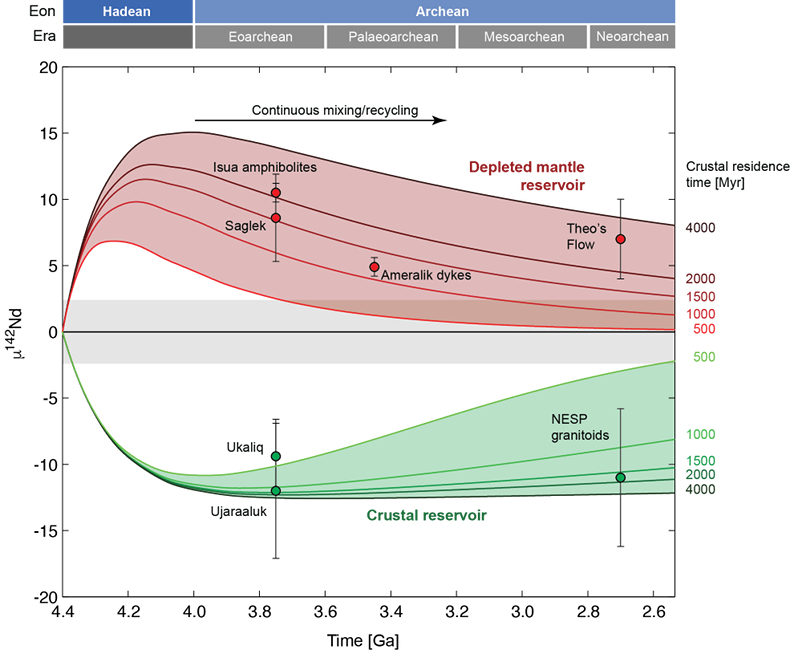
Figure 3 μ142Nd evolution of the depleted mantle and complementary crust as calculated by a continually interacting crust-mantle box model. The different coloured curves correspond to crustal residence times between 500 to 4000 Myr. The evolution of Isua μ142Nd data is best fitted for residence times between 1000-2000 Myr. Sensitivity of the inferred residence times to model parameters is detailed in Table S-5. The Hadean crustal component identified in Eoarchean Ujaraaluk and Ukaliq units in Nuvvuagittuq Supracrustal Belt and Neoarchean North Easter Superior Province (NESP) granitoids are also in agreement with crustal residence time of 1000-2000 Myr (O’Neil et al., 2012
O’Neil, J., Carlson, R.W., Paquette, J. L., Francis, D. (2012) Formation age and metamorphic history of the Nuvvuagittuq Greenstone Belt. Precambrian Research 221, 23-24.
; Caro et al., 2017Caro, G., Morino, P., Mojzsis, S.J., Cates, N.L., Bleeker, W. (2017) Sluggish Hadean geodynamics: Evidence from coupled 146,147Sm–142,143Nd systematics in Eoarchean supracrustal rocks of the Inukjuak domain (Québec). Earth and Planetary Science Letters 457, 23-37.
; O’Neil and Carlson, 2017O’Neil, J., Carlson, R.W. (2017) Building Archean cratons from Hadean mafic crust. Science 355, 1199-1202.
). Inferred crustal residence times are also consistent within error with the μ142Nd data for Theo’s Flow (Debaille et al., 2013Debaille, V., O’Neill, C., Brandon, A.D., Haenecour, P., Yin, Q., Mattielli, N., Trieman, A.H. (2013) Stagnant-lid tectonics in early Earth revealed by 142Nd variations in late Archean rocks. Earth and Planetary Science Letters 373, 83-92.
).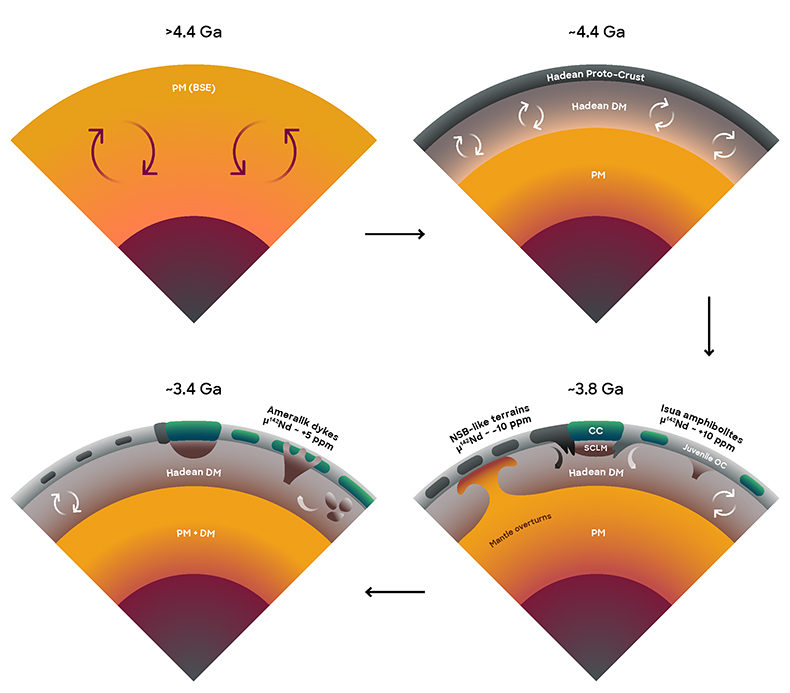
Figure 4 A schematic diagram illustrating the evolution of Isua Hadean depleted mantle and proto-crust. The Hadean depleted mantle (DM) and proto-crust formed by primary differentiation at ~4.45-4.36 Ga following the Moon-forming event. The Hadean proto-crust acts as a stagnant-lid due to its buoyancy and is reworked and recycled into the mantle during large-scale deep mantle upwellings in a lid-overturn tectonic regime (Bédard, 2018
Bédard, J.H. (2018) Stagnant lids and mantle overturns: Implications for Archaean tectonics, magmagenesis, crustal growth, mantle evolution, and the start of plate tectonics. Geoscience Frontiers 9, 19-49.
). Basaltic magmatism thickens the oceanic crust (OC) and results in formation of continental crust (CC) by intra-crustal melting and ensures stabilisation of cratons with a depleted subcontinental lithospheric mantle (SCLM) keel. ISB amphibolites are derived in the Eoarchean from the convecting Hadean DM metasomatised by crust-derived fluids. The NSB rocks possibly formed during reworking of the Hadean proto-crust in mantle overturn episodes recycling portions of the crust into the mantle. Ameralik dykes form in the Palaeoarchean during a delamination episode triggering decompression melting of the Isua Hadean DM.





